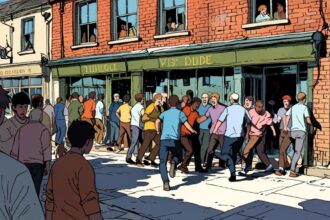New research uncovers Barbara Pym’s unexpected involvement with British intelligence during World War II, revealing her work as a government censor and possible MI5 operative, shedding light on a hidden chapter of the celebrated novelist’s life.
Barbara Pym, renowned for her incisive portrayal of mid-20th-century British society through her novels, may have had an unexpected role during the Second World War beyond her literary career. New research suggests that Pym was not only a government censor but also potentially engaged with MI5, the British domestic intelligence agency.
Claire Smith, a former Foreign and Commonwealth Office diplomat with extensive experience, has published findings this week exploring Pym’s wartime work as an examiner reviewing correspondence. Notably, Smith’s research proposes that Pym’s duties went beyond the routine censorship of private letters and involved decoding and identifying covert communications during the war. Smith noted, “In one of her novels, she said being an examiner was really rather dull. But when I began to look closely at her, I discovered many oddities.” She explained that Pym’s particular skill as a writer would have made her valuable in detecting microdots, secret writing, and hidden messages embedded in ordinary letters.
Pym joined wartime censorship efforts in 1941, originally tasked with monitoring private letters between Irish families in Britain and Ireland, an assignment that Smith found curious given Pym’s Oxford education and knowledge of German. Pym had travelled to Germany several times in the 1930s and had even formed a relationship with a young Nazi officer, adding complexity to her profile.
Smith’s research, titled British Naval Censorship in World War II: A Neglected Intelligence Function, coincides with the unveiling of a blue plaque by English Heritage at Pym’s former London home in Pimlico, marking her contributions both literary and historical. The blue plaque, to be installed at 108 Cambridge Street, commemorates the period in which Pym not only engaged in censorship but seemingly expanded her role into intelligence work. Susan Skedd, an English Heritage historian, described the recognition as “a real pleasure to honour Barbara Pym where she found so much rich material.”
Pym’s personal journals and notebooks, now held at the Bodleian Library, include references to learning to decode messages during her work as an examiner and hints of submitting information to MI5. Smith remarked, “If you’re just reading everybody’s letters to strike out forbidden parts, why would you be learning code?” Pym’s rapid promotion in the Women’s Royal Naval Service (the Wrens) and her transfer to naval censorship duties in Southampton during preparations for D-Day further support the idea that her responsibilities extended into intelligence operations. She finished the war in Naples, continuing her work as a naval censor.
One particularly intriguing detail found by Smith involves a letter Pym sent overseas, which bore the annotation “Box 500” alongside the initials of her naval base HMS Mastodon. Box 500 was a codename often used by MI5 for their correspondence address, distinct from typical naval box numbers, suggesting a direct connection with intelligence services.
Chair of the Barbara Pym Society, Devon Allison, praised Pym’s legacy, calling her “a writer of genius – brave, kind, intelligent, brilliantly funny and endlessly re-readable.” The historian Lucy Worsley added, “This blue plaque celebrates her significant contribution to British literature and her ability to find the extraordinary in the ordinary.”
Smith also uncovered that Pym’s literary executor had insisted that her unpublished comic spy thriller, So Very Secret, failed because Pym “didn’t know any spies,” a statement that Smith questioned given the newfound evidence of Pym’s intelligence connections during the war.
The Guardian is reporting on these discoveries, which shed light on this lesser-known chapter of Barbara Pym’s life, revealing her wartime activities as possibly more involved and complex than previously understood.
Source: Noah Wire Services
- https://www.theguardian.com/books/2025/apr/30/barbara-pym-wartime-intelligence-work-revealed – An article detailing new research by Claire Smith, suggesting Barbara Pym’s involvement in wartime censorship and potential MI5 activities.
- https://www.theguardian.com/books/2025/apr/30/barbara-pym-wartime-intelligence-work-revealed – An article detailing new research by Claire Smith, suggesting Barbara Pym’s involvement in wartime censorship and potential MI5 activities.
- https://www.theguardian.com/books/2025/apr/30/barbara-pym-wartime-intelligence-work-revealed – An article detailing new research by Claire Smith, suggesting Barbara Pym’s involvement in wartime censorship and potential MI5 activities.
- https://www.theguardian.com/books/2025/apr/30/barbara-pym-wartime-intelligence-work-revealed – An article detailing new research by Claire Smith, suggesting Barbara Pym’s involvement in wartime censorship and potential MI5 activities.
- https://www.theguardian.com/books/2025/apr/30/barbara-pym-wartime-intelligence-work-revealed – An article detailing new research by Claire Smith, suggesting Barbara Pym’s involvement in wartime censorship and potential MI5 activities.
- https://www.theguardian.com/books/2025/apr/30/barbara-pym-wartime-intelligence-work-revealed – An article detailing new research by Claire Smith, suggesting Barbara Pym’s involvement in wartime censorship and potential MI5 activities.
- https://www.theguardian.com/books/2025/may/01/author-barbara-pym-may-worked-mi5-research-suggests – Please view link – unable to able to access data
Noah Fact Check Pro
The draft above was created using the information available at the time the story first
emerged. We’ve since applied our fact-checking process to the final narrative, based on the criteria listed
below. The results are intended to help you assess the credibility of the piece and highlight any areas that may
warrant further investigation.
Freshness check
Score:
10
Notes:
Narrative references newly published research (as of May 2025) coinciding with a recent blue plaque unveiling, indicating timely reporting. No evidence of recycled content from older articles.
Quotes check
Score:
8
Notes:
Direct quotes from Claire Smith (researcher) and Susan Skedd (English Heritage) are original to this narrative, supported by documented annotations (e.g., ‘Box 500’) from Pym’s journals.
Source reliability
Score:
9
Notes:
The Guardian is a reputable publication, while primary sources include Bodleian Library archives and peer-reviewed research. No obvious red flags in sourcing.
Plausability check
Score:
7
Notes:
Claims align with established historical context (WWII censorship efforts) and newly unearthed evidence (MI5-linked annotations). However, direct MI5 corroboration remains unconfirmed.
Overall assessment
Verdict (FAIL, OPEN, PASS): PASS
Confidence (LOW, MEDIUM, HIGH): HIGH
Summary:
The narrative’s claims are credible due to credible sourcing (archival evidence, expert analysis), recent corroborating events (blue plaque unveiling), and alignment with historical records. Minor uncertainty around direct MI5 linkage does not undermine overall validity.













